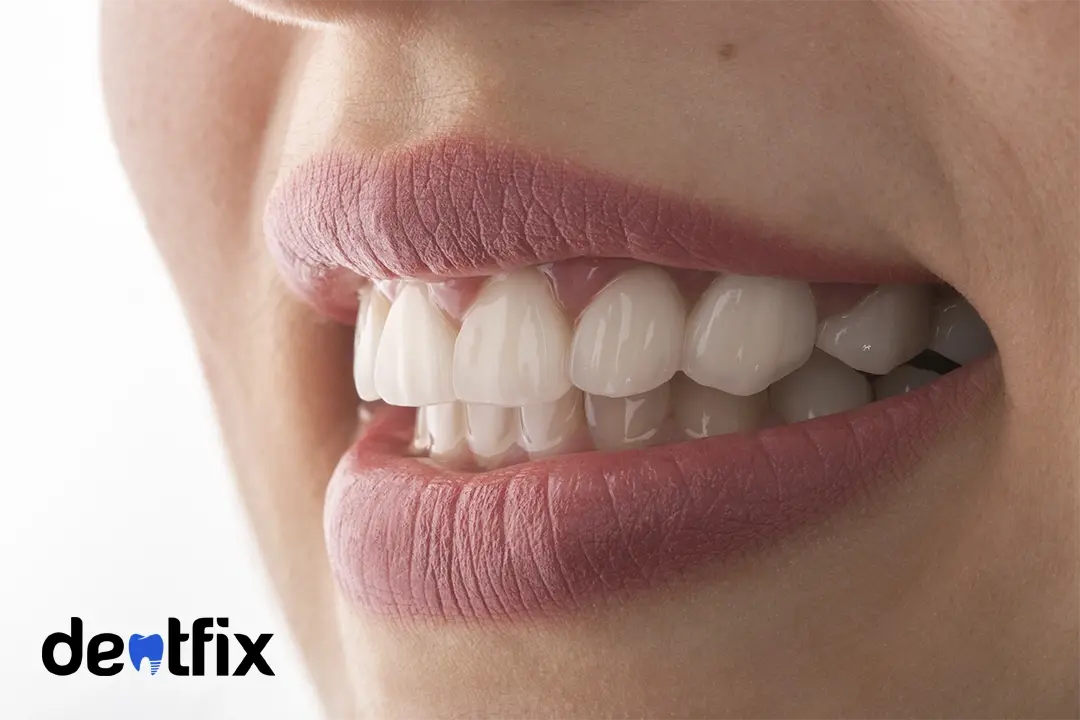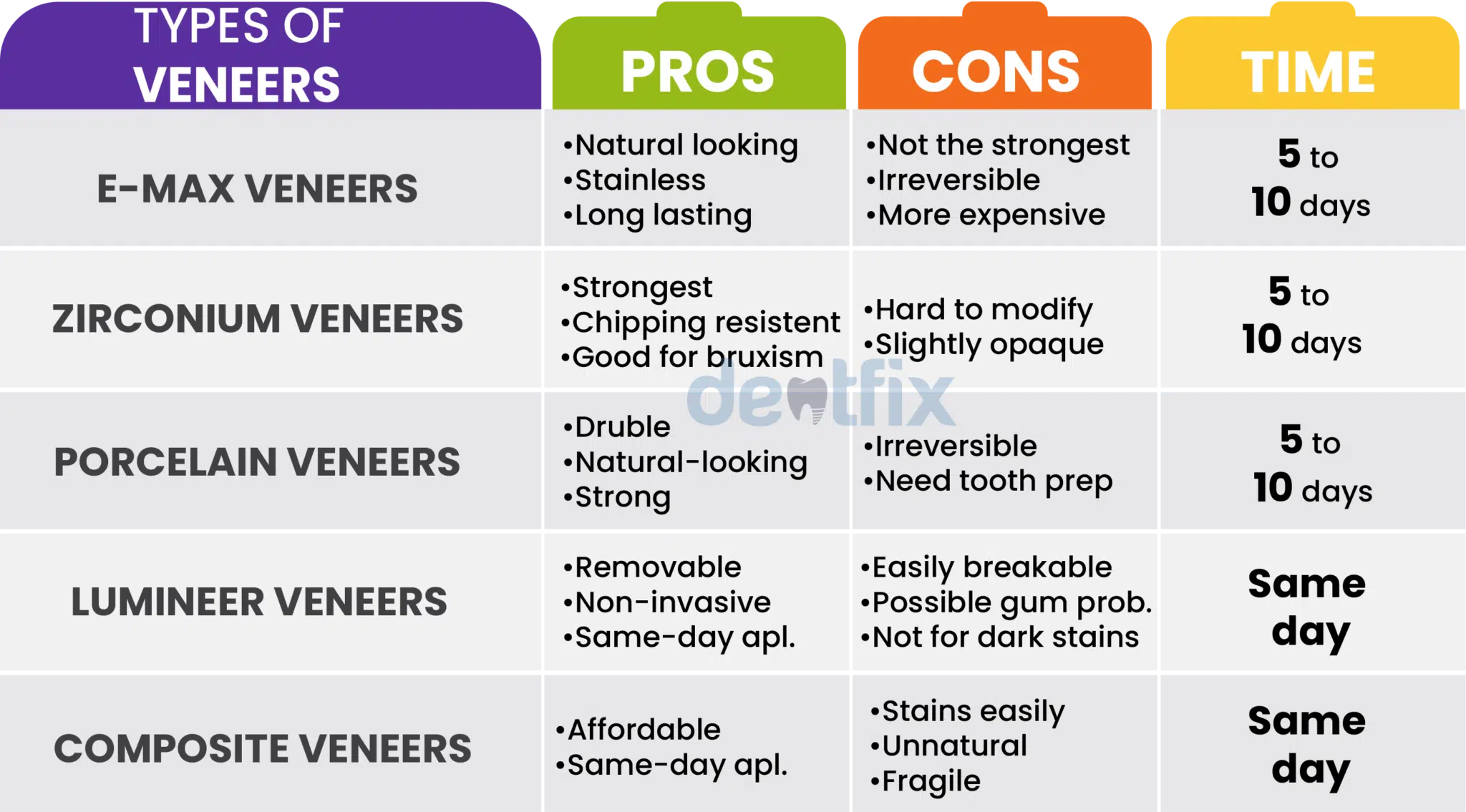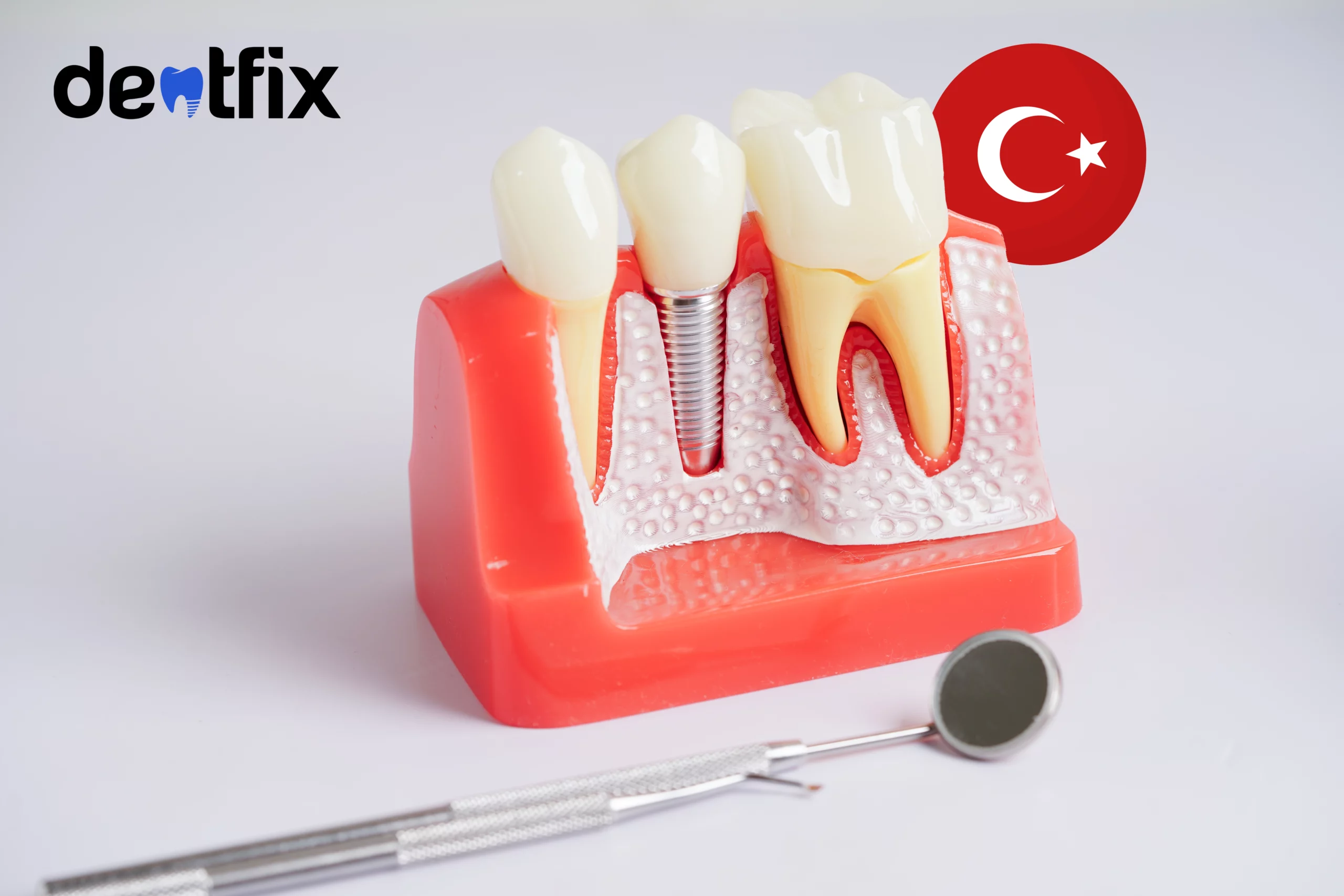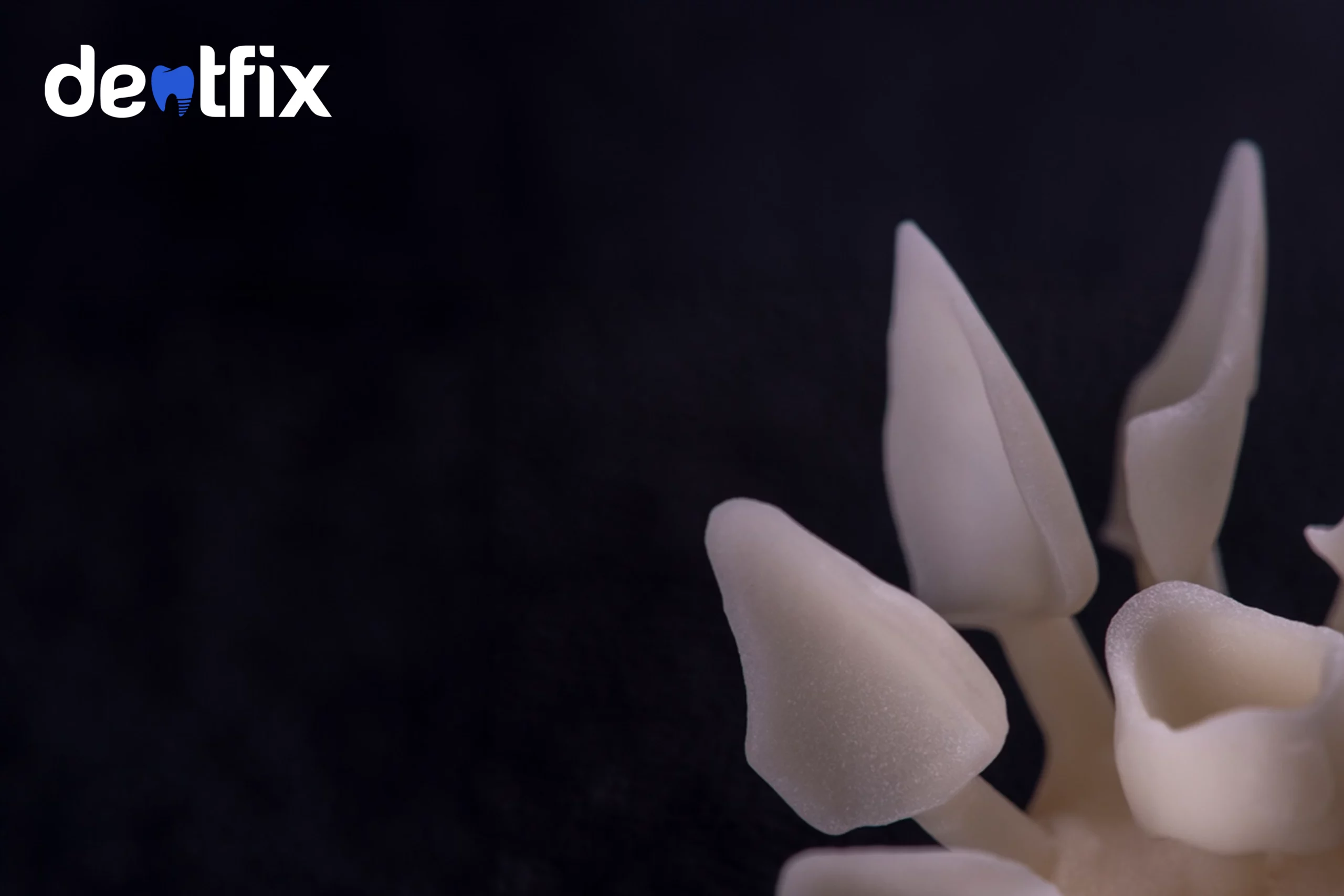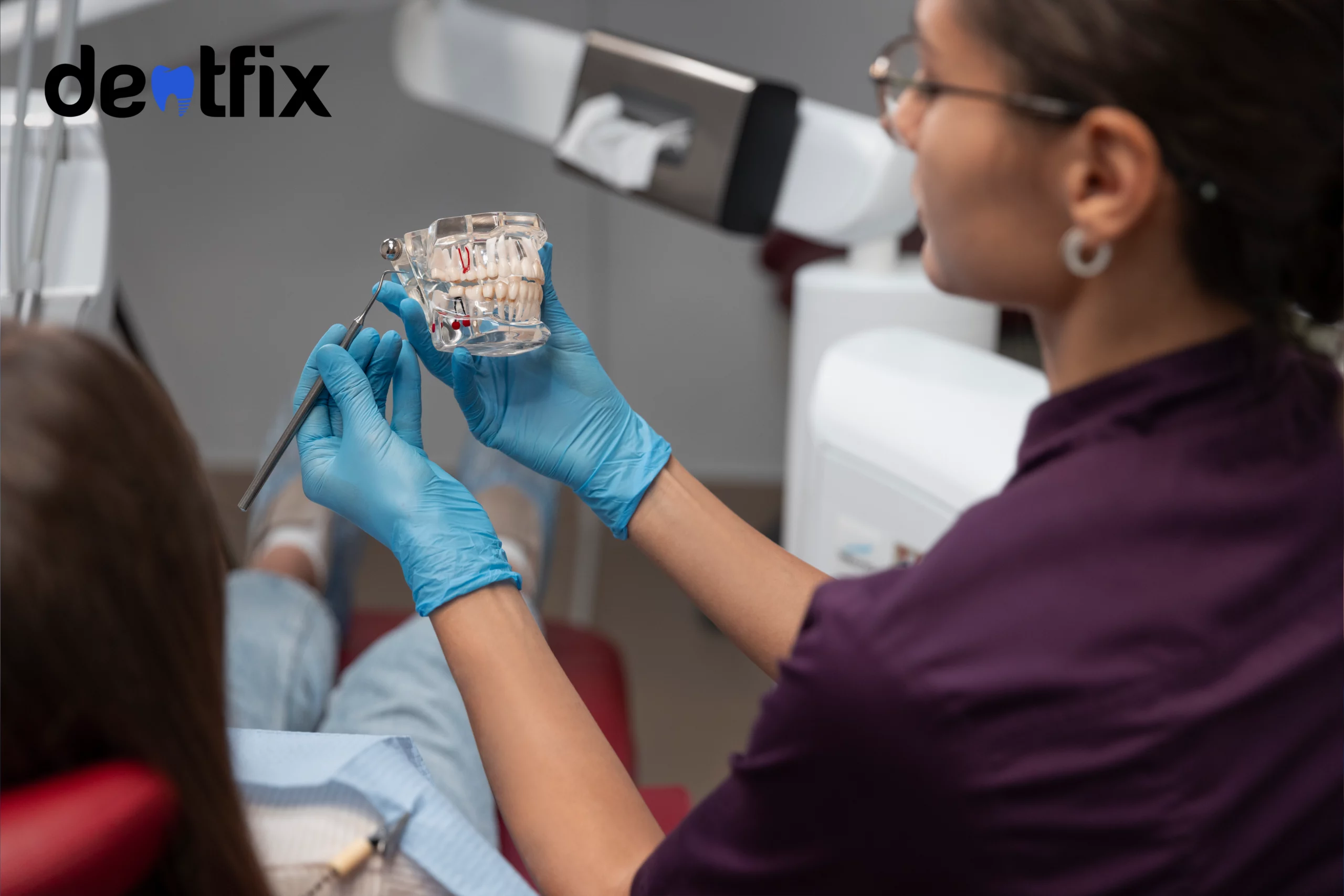If you’re here, you probably just finished the complete guide on Veneers. So what now? Now we go into every single type of veneer. And we mean every single one!
After reading this second guide on types of veneers you will learn everything you need to choose which type of veneer is perfect for you and what to expect from them.
When we talk about types of veneers we have to consider their many options. There are different materials like porcelain veneers, zirconium veneers, composite veneers, etc.
There are permanent veneers and temporary veneers. Also, the material affects the aesthetic features and the durability of veneers. This is why every type of veneer is better suited for different situations and needs.
But, without further ado, let’s go into this guide on types of veneers.
What are the different types of veneers?
There are two main types of veneers available in the dental industry and they are known porcelain and composite resin. Both of these materials are used in a wide range of sub-types of veneers such as E-max, Zirconia, Lumineers, and resin veneers.
Choosing a veneer depends on your budget, comfort level, dental situation, etc. We will try and make the process easier for you with detailed information about the different types of veneers for your beautiful smile.
Here is a list of types of veneers to make the process of choosing easier for you when you decide on your cosmetic dentistry procedure.
Permanent veneers
When we talk about permanent veneers we mean a type of veneer that is irreversible and lifelong.
Permanent veneers are the types of veneers that protect and enhance your teeth for a long period. When it comes to veneer cost, these are the most expensive in the market but also the most natural and long-lasting.
Here’s a recap of all the permanent veneers type:
| Type of veneer | Durability | Appearance | Strength | Ready in |
| E-max Veneers | 10-15 years | Transparent/Natural | Medium-high | 5-10 days |
| Zirconium Veneers | 15-30 years | Opaque | Medium | 5-10 days |
| Palatal Porcelain Veneers | 10-15 years | Transparent/Natural | Medium-high | 5-10 days |
| Porcelain Veneers | 10-20 years | Transparent/Natural | Medium | 5-10 days |
| Lumineer Veneers | 5-10 years | Semi-Transparent | High | Same-day |
| Composite Resin Veneers | 3-5 years | Opaque | Low | Same-day |
Of course, when we say permanent we do not mean lifelong. But since these dental veneers can mostly last anywhere from 10 to 20 years, they are considered permanent.
E-Max veneers
One of the most popular types of veneers, E-max veneers are from lithium disilicate glass-ceramic. They are one of the best in this day and age because of their natural aesthetics, strength, and durability. In 2017, a study on the efficacy of E-max veneers showed an 83.5% survival rate even after 10 years had passed.
With proper dental care, they can last more than 10 years without any dental complications. Due to their translucency, they have a unique quality of blending with your real teeth giving your smile a natural appearance. They’re also stain resistant which makes them easier to maintain.
But on the other hand, these veneers have a lengthy application process and are more prone to chipping and fracturing.
Zirconium veneers
One of the toughest veneer materials, Zirconium veneers are the perfect dental procedure to fix dental issues such as extensive decay, chipping, and fracture. Made of zirconium dioxide, one of the most resistant forms of monolithic ceramics.
It has exceptional strength because there are no other materials added to the mix. It is opaque in appearance, so it can have a dramatic effect on your teeth. They are ideal for tooth rebuilding in case of extreme tooth decay and provide high strength to the teeth overall. It’s also an option to fix the problem of discoloration because of its opaque appearance.
Speaking of opaque it could make the appearance of teeth a bit unnatural. They usually outlast most other veneer varieties because of their superior strength and quality.
Porcelain veneers
Porcelain veneers are among the most common types of veneers and it is easy to find them at a dental clinic near you. They are composed of feldspar, a naturally occurring glass ceramic. Feldspathic porcelain is a very thin and translucent material that gives a very natural look.
Another great advantage of having porcelain veneers is that they are resilient and do not stain, chip, or discolor that easily. This is one reason why they last for a longer time than any other type of veneer.
We have an article specifically talking about taking care of porcelain veneers so you can have all the information you need to make them last for as long as possible!
The only downside of veneers like porcelain ones could be the long tooth preparation process which leads to a long application procedure as well.
No prep veneers (Lumineers)
“Non-prep” veneers, no prep veneers, or minimal-prep veneers are single-visit veneer treatments that require minimal tooth preparation as a cosmetic procedure. They are thin and compact shells that are gently attached to your teeth to refurbish the old tooth surfaces.
Lumineers are considered to be a quick fix to treat chipped, misshapen, or discolored teeth. No-prep veneers include Lumineers, Durathin veneers, and Vivaneers. They are excellent for people who want veneers but do not want invasive procedures and a slightly less invasive veneering process.
Due to being thin, these veneers can easily get fractured or chipped. Also, they might not cover stains as well as other veneers because of their thin design. Gum problems are more likely to happen because of a bad fit.
Composite veneers
Composite veneers are used as alternate types of veneers which are much cheaper and quicker than porcelain veneers. The main component in composite veneers is resin, a tooth-colored dental restoration material. They have a better success rate when used on the front teeth rather than the posterior teeth because of their weakness.
When compared with porcelain veneers, composite veneers have a shorter life and they are more prone to stains, scratches, and fractures.
Composite veneers are also known as same-day and temporary veneers because they can be bonded quickly and need minimal enamel removal.
Same-day veneers
They are also called ready-made veneers that are designed, prepared, and applied on the same day.
Compared to standard porcelain veneers, these are made in a dentist’s clinic using an automatic milling machine with CAD/CAM technology.
The dental facets full process involves the preparation of the tooth, a digital scan of the tooth, and the creation of veneers. An automated machine is used to make the veneers on the same day.
Temporary veneers
Temporary veneers can be placed in two situations: First, when you are waiting for your permanent veneers to arrive. Second, as clip-on veneers.
Temporary veneers are mostly made out of composite resin that does not have a long life span. It is also easier to put them on and off because they are clip-on.
Temporary veneers are more suitable for people who want to test if veneers will suit them in the long run. Permanent veneers are a better choice for people who are looking for a long-term solution to dramatically enhance their smile.
It can be an annoying process to eat properly when you have temporary veneers as a placeholder. Luckily, we have an article talking about which foods to avoid and which foods to eat with temporary veneers!
Clip-on veneers (Pop on veneers)
These are removable veneers and don’t require any tooth alterations.
- Custom clip-on veneers
- Non-custom clip-on veneers
Custom clip-on veneers are available in porcelain and composite resin but their prices may vary. Clip-on veneers are easy to wear but you need to make sure you follow a proper cleaning routine to maintain them. Last but not the least, do not eat hard or chewy foods while wearing your clip-on as they can potentially damage them.
Then there are non-custom clip-on veneers that do not require any prior tooth preparation or visits to your dentist, you can buy them at the drugstore and instantly put them on. Again, they are good for temporary use and are not customized so they do not give realistic results.
How long do veneers last?
The duration of a veneer depends a lot on the material used in them, your dental hygiene, and your eating habits.
So, how long do veneers last?
- All-Porcelain: 7 to 10 years
- E-max: 10 to 15 years
- Zirconium Veneers: 15 to 30 years
- Lumineers: 10 to 20 years
- Composite Resin: 3 to 5 years
Of course, these durations are based on the assumption that proper care and maintenance are provided. However, your veneers can show some signs of wear and tear that indicate it’s time to replace them.
How to choose the best types of veneers?
Several factors should be kept in mind when choosing veneers for the perfect smile. The three main factors include shape, material, and budget.
Once you decide your budget and what your dental needs are, you can easily decide the shape/size & material of your veneers.
Before you do anything, make sure to discuss your dental issues with your cosmetic dentist so that you can get professional advice on your future flawless smile. Various types of veneers offer their own advantages and disadvantages.
What’s the best veneer material?
Every type of veneer has different benefits. However, porcelain ceramic veneers are considered to be the best material for veneers. They are long-lasting and translucent which means that they match your real teeth and do not look fake. Porcelain veneers also do not stain very easily and look as good as new ones for a long time.
If you want the best material but are afraid of the high cost, you may consider getting veneers in Turkey.
How to choose the best types of veneers material for your face?
In order to have a beautiful, natural-looking smile you should know what types of veneer material work with your face. The shape of your face plays a big role in deciding the best type of veneer.
Here is a general guide on face shapes and the kind of veneers that generally suit them more than others:
- Heart-Shaped Face:
Although they can pull off most of the shapes, rounded veneers suit them a lot better than other shapes. - Oval-Shaped Face:
Since they have a long and equally proportioned face structure, square-shaped veneers suit them more. - Round-shaped Face:
For rounder proportions, it is better to opt for longer, more pronounced veneers. - Square-shaped Face:
Since this face shape is small, rounded, and less edgy veneers are more suitable for them.
For example, a heart-shaped face should have shorter and more rounded veneers. Whereas an oval-shaped face can easily pull off a more squared veneer and it’ll be less noticable.
Why do some veneers look fake?
Fake dental facets can be spotted easily if they don’t match your real teeth and something about them is noticeably odd. Horse-teeth kind of odd.
Veneers should ideally look as natural as possible and a qualified dentist will make sure your veneers don’t stand out in the wrong way.
Here are a few ways you can easily spot a fake-looking veneer:
- They are unnaturally white and there is a major color mismatch between your veneer and the rest of the teeth.
- The edges are pointed and sharp which looks odd as compared to the rest of your teeth.
- They have an extremely opaque or non-translucent appearance, i.e. light doesn’t pass through them. A normal porcelain veneer would be semi-translucent with a neutral enamel tone.
- No space between veneers that easily gives out that one is wearing a veneer. There should be little spaces between your veneers so that they can look completely natural.
- The veneers are too big or small for your face shape. The measurements of your veneer should complement the shape of your face.
If you’d like to learn more tips on how you can avoid the unnatural, horse-teeth look, you can check our article.
What should I tell my dentist before choosing the veneers?
The success of veneers can be influenced by various factors, and it’s important to inform your dentist of certain information to assess whether you’re a suitable candidate for the procedure. Let’s take a look at them!
Goals: What’s the goal you want to reach when getting veneers? Think about it and discuss your goals with the dentist.
Budget: Setting up a budget is a great way to pick the right kind of veneers. Knowing how much you can afford will help you navigate through all the different kinds.
Issues: Discuss all your dental issues with your dentist. Discussing your concerns and dental needs is a very important step before getting veneers.
Side Effects: Talking about the possibility of veneers’ side effects is important, as you should take a decision also based on it.
At Dentfix we have a diligent team of qualified cosmetic dentists who will be there for you every step of the way. They will listen to your concerns carefully and provide ideal solutions to the problems.
What are removable types of veneers?
Removable veneers are temporary veneers that can be taken off whenever you want. They include clip-on or snap-on veneers and they are custom-made by a professional dentist.
Removable veneers are also available in drugstores that are ready-made and are not customized per your teeth.
What are prep and no-prep veneers?
The difference between prep and no-prep veneers is in the tooth preparation.
“Prep Veneers” require tooth modification, even if conservative. The dentist shaves off a thin layer of your tooth to place the veneer. Prep veneers include traditional porcelain veneers and composite resin veneers.
“No-Prep Veneers” are those types of veneers that do not need initial preparation for veneer attachment. These include Lumineers, Vivaneers, Durathin veneers, and clip-on veneers. Although they are quick and pain-free, they can stain more easily than the other traditional types of veneers.
Well, we hope that you were able to come to a conclusion on which type of veneer you’d prefer to get. Now, let’s move onto the next chapter where we will talk about how veneers are applied!
Reference:
Alothman Y, Bamasoud MS. The Success of Dental Veneers According To Preparation Design and Material Type. Open Access Maced J Med Sci. 2018;6(12):2402-2408. Published 2018 Dec 14. doi:10.3889/oamjms.2018.353 https://www.ncbi.nlm.nih.gov/pmc/articles/PMC6311473/
